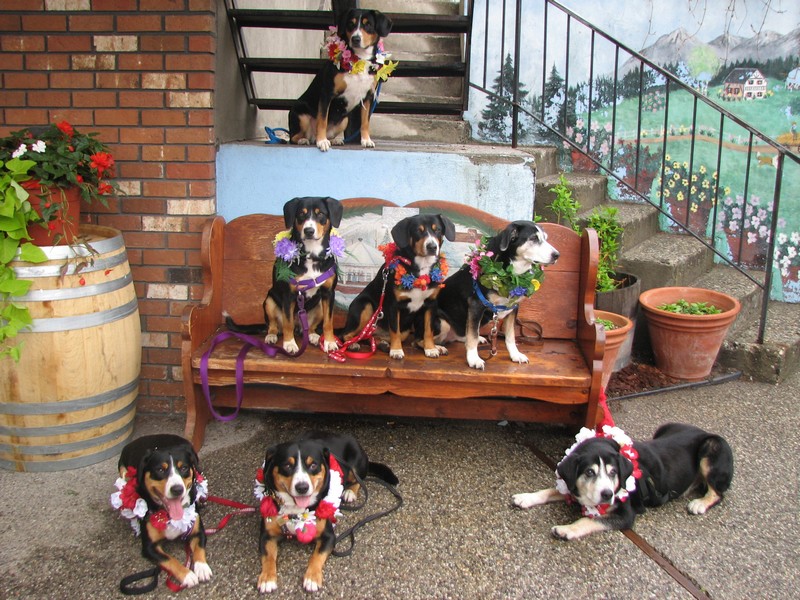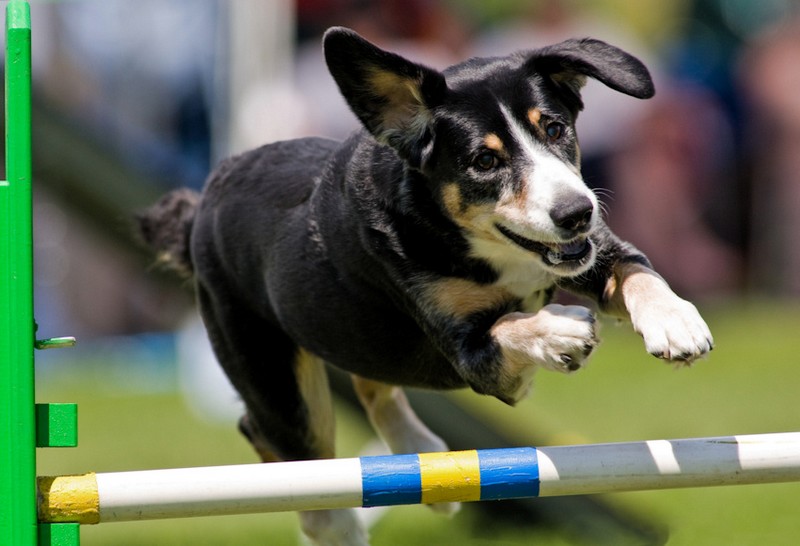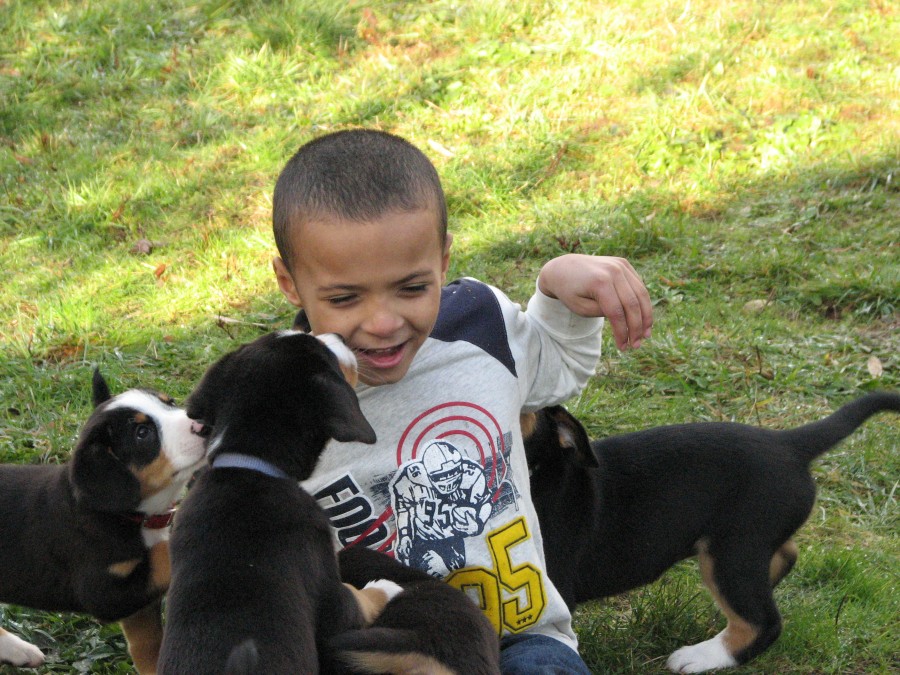Frequently Asked Questions
1. What kind of environment do they like?
 Entlebuchers do not like the heat, so they are not suited to live in year long heat areas such as Florida. They prefer to have lots of space and be able to come into your home, since being with you is their favorite thing. They are not meant to be kept in a kennel or dog run while you are away at a 9 to 5 job. Being confined would drive them crazy; these are working dogs which mean they need something to do. They like to be part of the family, the more kids and animals the better!
Entlebuchers do not like the heat, so they are not suited to live in year long heat areas such as Florida. They prefer to have lots of space and be able to come into your home, since being with you is their favorite thing. They are not meant to be kept in a kennel or dog run while you are away at a 9 to 5 job. Being confined would drive them crazy; these are working dogs which mean they need something to do. They like to be part of the family, the more kids and animals the better!
2. How much exercise do they need?
They need to be active. These dogs are not for sedentary people. They need moderate to high exercise. They like to play ball, Frisbee, catch or anything that you can come up. Use your imagination. They can learn to run along side you if you are a runner but this will need some training as their instincts to herd you will be most apparent. They like hiking, camping and even retrieving sticks thrown into the water. They like the water but are not like Labs. They can be good swimmers but it may take some coaxing, like throwing a favorite floating toy into the water or going in the water with them.
 3. Are they good watchdogs?
3. Are they good watchdogs?
Yes, they bark for good reasons. When they hear something outside the home they will let you know. You can train them by a word or even a bark mimic. Our command is ‘ Go see’. Their bark is loud and deep. Some Entles have very strong guarding instincts – an important trait to consider when deciding on a puppy.
4. How much do they cost?
This breed is still rare in North America and therefore the price is higher than some other breeds. The average price is $2000 for a NEMDA certified BCOE (Breeders Code of Ethics) breeder. Our range depends on the pups, spay/neuter agreement or for breeding. So it depends on what you want. There are some newer breeders selling for less but in the end, you do get what you pay for. Getting an Entlebucher is like adding a new member to the family.
5. What kind of temperament does this breed have?
The Entlebucher is a Cattle dog, used for driving cattle. They are strong willed and require consistent and firm training. They are intelligent, stubborn but willing to please. Matched with an intelligent and skillful handler they can be a wonderful dog. When you get this breed as a puppy you need to establish yourself as “alpha”. The dog will naturally try to be alpha so you must let him/her knows who’s boss; that includes all members of your family. Two good books we recommend are How to Raise a Puppy You Can Live With by Rutherford and Neil (very effective training tips and easy to read) and The Art of Raising a Puppy, by the Monks of New Skete. The Monks breed and train German Shepherds and their training methods work really well with Entlebuchers. You should start puppy training right away. We recommend puppy kindergarten as soon as the required inoculations are given and then Level 1 Obedience Training at 6 months. Socialization during the first six months after you get a puppy is very important, so please read those books in full about socialization and training. There are lots of things you can do to make your dog an outstanding citizen and a tribute to his doggie race.
6. What about obedience training and for show?
Entlebuchers excel at this. They can become champions with consistency and hard work. They can learn fast but need firm training. It is very important for the owners to do the training themselves. Sometimes people send their dogs to be trained but they end up minding the trainer and not their human parents. They also excel at agility and herding. These activities are a lot of fun for the dog. It can be hard work at times but in the end the dog will be healthier and happier because he is well trained and has something to do. The Entlebucher is an athletic dog and likes attention so structured activity with his favorite person is a blast for them and for you!
 7. Are they good with children?
7. Are they good with children?
Yes, they love children. Some Entlebuchers are very tolerant and gentle of young children (like Shaman was). But there are others who are too rambunctious and enthusiastic around them and can end up hurting them by jumping up and nipping. Entlebuchers want to play above all else so it is good to have children who are devoted to playing with their four legged friend. We recommend that children be 4 years or older before getting a puppy. A young child and a puppy should never be left alone unsupervised. If you have toddler age children it might be a good idea to get an older dog that has been socialized with children.
8. Where are your dogs on the Breed Standard Spectrum?
Tail docking: We do not dock tails except for medical reasons. We follow the humane European standard on tail docking.
Size: We produce puppies that are usually in the middle of the standard. Medium sized means the girls are 45- 50 pounds and boys are 55-60 pounds when full grown. We breed for athleticism and a working attitude. “Compact” means a dog that is agile and versatile in its physical make up.
Temperament: “Suspicious of strangers” can be applied to a spectrum of temperaments. We know of Entles who won’t allow ANY person inside the front door who isn’t part of the family. The average suspicious translates to a deep bark for the greeting, followed by an aloofness to the stranger. Eagleheart dogs are at the sweet end of the spectrum: a bark or two, then you are their best friend. Since temperament is largely inherited, it’s extremely important to decide which part of the spectrum best suits you and your environment.
9. What kind of health problems do they have?
This breed has some eye problems, both cataracts and glaucoma (which has appeared recently), both are hereditary. Breeders should check for this every year. PRA (progressive retinal atrophy) used to be a problem but there is a genetic test now that allows breeders to breed appropriate matches in order to not produce afflicted dogs. Make sure you know the prcd status of the mom and dad. You should ask to see the eye CERF before purchasing an Entlebucher. Hip Dysplasia is found in every breed, so every breeding dog should be checked for this and you should ask to see the OFA rating certificate. Some dogs are having PennHIPP done so ask to see the evaluation sheet. All Entlebuchers breeding dogs should have a passing OFA (Fair or better) as that is the most important criteria that measures the bone structure. A dog can have a good PennHipp score (measures laxity of the hip joint) but fail the OFA evaluation. Another fairly rare health problem is EUS, Entlebucher Urinary Syndrome, (ectopic ureters). We are grateful that has not shown up in our line.
The bottom line is, as breeders we do the best we can to screen for problems before breeding. When selecting a sire for our dams we analyze the pedigree very carefully and do research on what they have produced. We select a sire that does not have any lineage matches for at least three generations. We do not do In-line breeding.
10. What about purchasing a dog for breeding?
If you decide to make the commitment to breed, always wait until your dog is at least two years old, especially for the female. Her body is not full grown until two years and breeding her young can have adverse health effects on her. These dogs take two full years to physically mature and you will need to wait until after the tests have been performed. You need to get the hips rated and the eyes CERFed once a year. You don’t want to breed a dog that has poor hips or that does not pass the eye CERF test. The gene pool is not very large in North America, so it is very important to breed only very sound dogs. Breeding these dogs takes a lot of effort, time and money, so please don’t buy this dog to make extra income because it doesn’t work that way.
11. What about feeding and grooming?
These dogs do not require much grooming as their coat is short and thick. This breed is not like a poodle where they need to go to the groomers all the time. If you feed them a good lamb and rice or chicken and rice food, their coat will stay shiny and healthy. This breed can be prone to chubbiness so match the feedings to activity level. Nail clipping is important to do; teeth brushing is always a good idea too. Or give them lots of chew bones (this cleans their teeth and gives them something to do.)
12. Are they a good inside dog?
Yes, for reasons mentioned above, they are clean and neat. They do shed in the spring time and around their heat cycle if you have a breeding female. If you live in a rainy climate it is easy to dry them off. We live in Oregon and there is always a towel by the door. And no they are not droolers (except at mealtimes). But they are an active breed and will not be content to hang around inside the house all day.
13. What else do I need to know about getting a puppy?
Be sure to read the books, and be prepared to spend lots of time during the first 6 months with your puppy. By age 6 months they are about 4 times the weight when you got them at 8 weeks. One thing not mentioned thus far is Entlebuchers can become very attached to their owners and can experience separation anxiety. This can mean excessive barking, howling, or destructive behavior while you’re gone. To avoid this, isolate your new puppy for a few minutes every day. You can increase this time apart to a few hours after they are several months old. Crate training is a good idea also, especially for housebreaking. Getting them used to the crate is also very important if you want to fly with them later. We know of one Entlebucher boy who was not crate trained and when they put him in a crate he made his paws bloody trying to get out. Puppyhood is a great experience and does not last that long in terms of their size so have the camera ready. These dogs have a puppy mind in a big body for almost 2 years.
14. Are there any good books on this breed?
Well, sort of, there is a book on all the mountain dogs called: The Bernese and Other Mountain Dogs, by Gerd Ludwig. It is published by Barron’s and can be ordered at most book stores. I agree with most of his tips, but he does go a little overboard on the grooming and feeding requirements. He says not to disturb the dog while it is eating or it may react aggressively. I think you should teach your dog not to be bothered when you are around their feeding bowl. I even put my fingers in the bowl to train them to be nice when eating. ‘Don’t bite the hand that feeds you’ is a good saying!
If you have further questions, please feel free to ask.